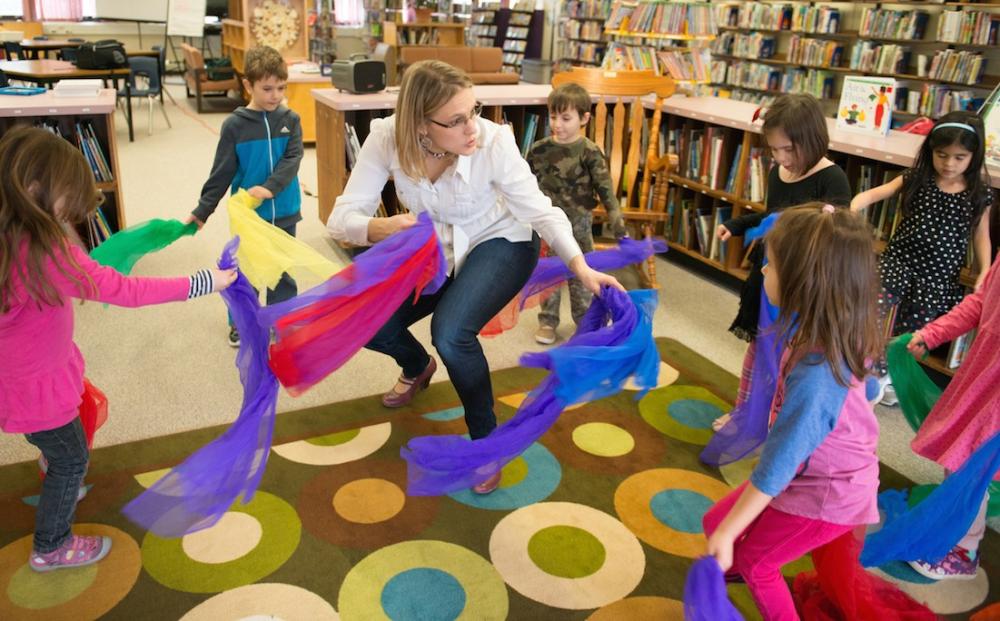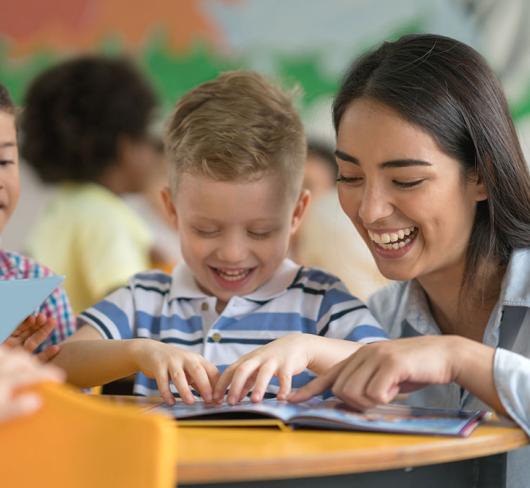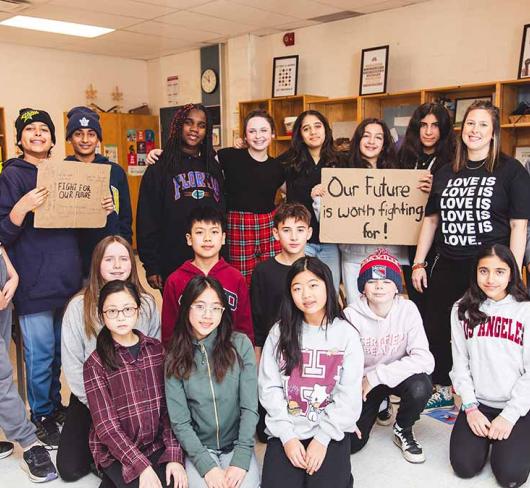
Dance Is Elementary to Education
I didn’t always consider myself a dance educator. In fact, when I began my elementary teaching career I thought of myself as a math and science specialist. It wasn’t until my first professional learning experience in dance education 10 years ago that my mindset shifted about the benefits and value of dance education. I began exploring how dance and movement could be used to unlock students’ abilities to take risks and think critically, build their mental health and well-being, and encourage creativity. As I watched students use their bodies for learning, as well as instruments of expression, I witnessed their engagement in school increase. Since then, I’ve plunged myself, and my students, into the world of dance. Dance develops students’ creativity and ability to problem-solve collaboratively, two of the most important skills needed by twenty-first-century learners. Giving students the freedom to make choices within a structured program encourages them to reach beyond what comes easily, use their imaginations and test their personal boundaries. Dance also enables students to better understand themselves and the world in which they live. I have come to realize that dance education is more than movement for fitness or entertainment. Dance education today concentrates on process, the process of using the body to
- Express an idea
- Think about and challenge opinions
- Develop emotional understanding of self and others
- Revise and refine choices through critical analysis.
Planning and Organization Are the Keys to Success Effective dance programs are highly organized and require both teachers and students to be keenly observant. As students move around the room, they must watch where their bodies are in relation to other dancers and objects in the room. They can choose to keep their personal space at a distance, or they can choose to engage with other dancers and objects. This requires students to think quickly and critically about the quality and quantity of their interactions. One of my roles, as teacher, is to side-coach – to ask students meaningful questions while they create to expand their thinking on what is possible within their piece. Dance is a discipline of study like any other subject area, and I put as much critical thought into my dance program as I do into my literacy and math programs. My long-range plans follow students’ continua of learning as dance creators through careful selection and scheduling of learning and assessment experiences. Students develop their understanding of dance content knowledge. Dancing, dance creation and performance appreciation are important parts of every arts program. The classroom environment must also be considered in establishing an effective dance program. Some questions I ask are: How might the classroom be best utilized? Should an alternative space be used? What safety expectations will we co-establish? Are there clear sightlines? Are there tripping hazards? Will students be using props, and how will that affect the use of space? What techniques can be used to quickly gain students’ attention either during or after a movement task? Once the classroom environment has been established and students are ready to begin, I have three favourite practices for gaining my students’ attention.
- Neutral: This is the first signal I teach students. When the students hear me call “neutral,” they stop and stand in their individual bubble spaces with arms at their sides.
- Tibetan chimes: This sound resonates above the constructive discussion in the room. The students stand in a neutral position to show that they have heard the sound.
- Rainstick: This sound is perfect when we are conducting small group discussions, independent practice or small group performance practice. It’s subtle and keeps everyone in a calm state as they return their attention to me in either a sitting or standing position.
Begin with the Elements of Dance Students always begin with an exploration of the fundamentals, the elements of dance. Students explore how to
- Move their bodies to create shapes
- Use energy to enhance the quality of a movement
- Engage with one another in space and through time
- Express a word or simple idea through body movement.
This creative movement exploration permits students opportunities for free-expression by working with everyday movement and body language. That is how we spend the bulk of our dance time. It’s not primarily about learning and performing specific dance styles, like folk dancing or hip-hop, although learning dance genres does have its place and time. It is always astonishing to observe how well the students engage in the movement experience. When I observe Grade 1 students make shapes with their bodies, arms go out wide, legs go in the air and a quiet laughter starts to fill the room. An energy word, such as twist, pull or sway, is announced and students start to explore how to express dance language through whole body movement. A little silliness erupts, but that is to be expected as Grade 1 students are still learning self-control. The Grade 5 students’ movements, however, are more controlled. Shapes are held with precision, and the room is calm and composed. These students know how to automatically adjust for levels (high, medium, low) in order to create visual interest for the audience. There is a slight pause when the music starts. Students are analyzing the duration and dynamics of the song before energizing their movements with dynamic qualities. Learning experiences for the remainder of the year are always rooted in or stem from the elements of dance. Sharing usually happens in the classroom and is mostly viewed by the group or captured on an iPad for group and personal analysis afterwards. Students examine their movement pieces to discuss content knowledge, celebrate successes and provide descriptive feedback to one another. Elements of Dance Body: The instrument of dance. The term body may also refer to the body’s position or shape (e.g., curved, straight, angular, twisted, symmetrical, asymmetrical), or how the body is moving (e.g., locomotor or non-locomotor movements). Energy: The force with which the body moves (e.g., light, strong, sustained, sudden). Relationship: The way in which two or more things are connected to or associated with one another (e.g., dancer to dancer, dancer to object, right arm to left arm). Space: The physical area in which the body moves; also, the area surrounding the body. Time: An element of dance involving rhythm, tempo, accent and duration. Time can be based on measured beats, as in music, or on body rhythms, such as breath, emotions and heartbeat. Source: Ontario Ministry of Education (2009). The Ontario Curriculum, Grades 1-8: The Arts. Expanding on the Elements Once students have had a chance to explore the elements, they are ready to explore movement phrases and dances. The activity that follows is one that I have used successfully for eliciting prior knowledge, exploring a story or discussing current events.
- Have the students stand in a bubble space or personal space in the classroom.
- Introduce a topic such as “spring.”
- Invite students to bodystorm words, phrases and themes that have to do with the topic and to use their bodies to express their ideas through different elements of movement (e.g., body shape and level).
- Encourage students to share their movements and word/phrases with the class.
- Record words/phrases on chart paper.
- Organize students in groups of five or six in a circle formation.
- Ask each group member to choose one word/phrase from the chart and create a movement to go with that word.
- Have students demonstrate their movements one at a time so that the other group members can imitate the move.
- Repeat this until all moves are learned and consolidated by all group members.
Later students may wish to try performing to music. Slow and melodic music works best to start. Try introducing faster tempos once the students become more comfortable with the movement phrase. An excellent resource for teachers is the Council of Ontario Drama and Dance Educators (CODE). This active subject association encourages and supports teachers in the implementation of drama and dance programs that focus on differentiated instruction, creativity education and inquiry-based learning. The CODE website at www.code.on.ca houses a variety of resources at all levels to assist educators in the planning and delivery of quality dance education programming. There is also a yearly conference and regional events that connect teachers across Ontario, Canada and internationally. Dance Across the Curriculum Once the fundamentals have been consolidated, students are ready to engage in cross-curricular learning. Our Grade 1 students explore poetry by expressing their thoughts and feelings about a poem through movement. They learn to work collaboratively and empathetically, and to problem solve. Our Grade 4 students critically examine how body movements and the way a person carries oneself may have contributed to a person’s status or position of power within ancient civilizations. They analyze hierarchy systems and challenge their positions in order to revise and refine movement choices. A favourite Grade 7 lesson blends dance with a science strand, form and function. Student N.K. explains: “In dance, L.M. and I worked together to show tension by standing far apart and holding our hands together as we leaned back. We then broke away from each other to show shear. We added the energy “twist,” to show torsion is a twisting motion. For compression L.M. and I came back together and used the energy push to show how compression is a push. We put our backs together and pushed on each other’s backs.” Tips for Establishing the Dance or Creative Movement Environment
- Have a positive attitude towards the subject of dance; students will value dance and creative movement if you do.
- Get students up and moving as quickly and as often as possible; share the next task while the students are moving.
- Demonstrate the benefit of collaboration; allow students who may be less confident the right to pass.
- Focus on exploring the elements of dance, and create a word wall just as you would for any other subject.
- Encourage your students to try movements before deciding to accept or reject a creative choice.
- Post the “creative process” cycle from the Ontario arts curriculum in the classroom, and refer to it during other subjects as well as dance to empower students to make the connection between how the creative process applies to all subject areas, not just dance.
- Co-establish clear expectations for self-regulation and body control; be consistent with your expectations.
- Have cards with “10 minutes left,” “5 minutes left” and “1 minute left” to use as a countdown towards the end of group work tasks; students appreciate knowing how much time they have left before they are asked to share their pieces with the larger group.
Student Well-Being Dance education plays a key role in the mental, social and emotional well-being of my students. Dance is important to their growth, self-esteem and creative expression, and allows them to think, feel and move simultaneously. In this digital age, students need opportunities to learn who they are and how they can interact with others in the world. Dance fosters opportunities for discussion and practice around self-regulatory skills. In a safe and secure environment, students are able to explore how to express feelings, interpret the emotions of others and practice being empathetic people. Students can also improve their abilities to self-regulate to a calm and relaxed state for learning when their energies are too high and unbalanced, or too low and sluggish. For example, I spend a lot of time during the year working with Kindergarten students on their ability to read and display basic emotions (e.g., happy, sad, angry), as well as to begin to explore more complex emotions (e.g., confused, frustrated, bored). This enables students to develop their ability to self-regulate in response to situations they encounter. In the end though, what is most important is the fun that students have when they are engaging in dance education. Dance brings joy to all learning. Clyre Lyndley is a member of the Elementary Teachers of Toronto Local. She is on the executive of the Council of Ontario Drama and Dance Educators.

